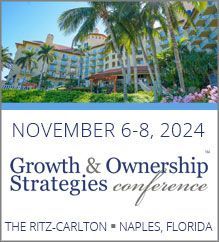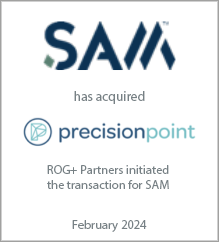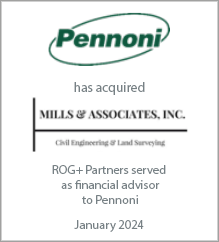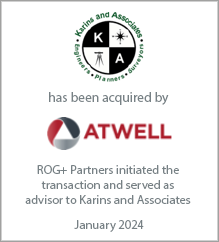Michael S. O'Brien is a principal in the Washington, DC office of Rusk O'Brien Gido + Partners. He specializes in corporate financial advisory services including business valuation, fairness and solvency opinions, mergers and acquisitions, internal ownership transition consulting, ESOPs, and strategic planning. Michael has consulted hundreds of architecture, engineering, environmental and construction companies across the U.S. and abroad.
Is Your Business Focus Hurting Profitability?
Is Your Business Focus Hurting Profitability?
May 20, 2019
Companies often say they’re client-, design- or employee-focused. The purpose of identifying your focus helps to communicate how you execute business strategies with your employees, clients, competitors and shareholders. Firms employ these focused strategies to create a path for delivering value and enhancing profitability. These are excellent examples of the types of possible focus areas to consider for your company. However, do they truly capture the essence of your company?
An increasing number of engineering firms enjoy earnings before interest, taxes, depreciation and amortization (EBITDA) margins ranging from 20 to 35 percent of net service revenues. They possess strong labor multipliers of 3.4x to 3.8x (even with public clients) and utilization rates of 60 to 65 percent. You get the idea: they’re profitable, and they’re not sweatshops.
The Secret Sauce
First I want to share a common theme I picked up on during the “Great Recession.” At the start of the economic decline, many firms rapidly reduced the size of their workforce to stem their losses. During this same period, many firms confided to me that several of their employees probably shouldn’t have been hired by them in the first place. Harsh, I know, but these same companies also told me that before the market collapse, they couldn’t find project managers quickly enough to keep up with project demands from their clients. And there it is: project managers.
Projects Before Clients
It’s my experience that architectural firms, for the most part, enjoy stronger profit margins when compared to engineering firms. I thought this was because of the nature of the work they perform, but I stand corrected. It’s now my belief that their studio business model may play a more-significant role. Many architectural firms center their business around project management of a particular type of building design, which resembles the studio model.
Engineering firms, however, tend to center business around clients. They focus on meeting the needs of the clients—not the needs of the project—by delivering their services in a client-centric manner. This focus on clients may come at the expense of profitability because your employees are likely focused only on one small part of the project delivery: the discipline of what they know. A project manager looks at the whole picture of project delivery. To deliver a more-complex suite of services to a client requires a great project manager, not a great engineer.
Everything your firm does involves leading a project for your client. The client is only concerned about you delivering the value of services needed in a timely fashion, and your project managers should function as the CEO of all their projects. The corporate division should be in the role of leading and supporting the project managers to ensure they have all the tools needed to be successful. Corporate will provide finance, accounting, business development and human resources (training, hiring, etc.). In other words, your project managers should be leveraging what corporate provides as well as directing the technical staff on project delivery.
Services may change from project to project, but how you manage those projects should be consistent. Firms enjoying EBITDA margins well above industry norms are project-management-centric organizations. They’re very particular about how they select and develop project managers. The project manager might not be the most technically competent, nor will they be required to be well versed in all aspects of engineering solutions of a multidiscipline firm, but they should possess strong business acumen.
A great engineer might not make a great project manager, just as a great project manager might not make a great engineer. The path to efficient project management should not be based on years of experience, but instead should be an exalted position based on the skills of the individual.
Leading Stats
I reviewed some critical statistics of several of these companies that adopt this belief. The typical ratio of employees to project managers ranged from 4.82 to 5.35, so if you have 500 employees, you may only have 100 project managers, and they must lead their many projects—not manage their projects. If your project manager spends a lot of time working in their projects, it’s very likely that they’re not leading.
So how do you organize your firm to be a project-centric organization? Let’s use a multi-state, multi-office scenario as an example. The executive team will lead the regional leaders, the regional leaders will lead the project managers, and the project managers will lead the services. Keep in mind that the expertise of your service will have technical leaders: this is where you see your matrix organization formed. But now you’re leading with a project-management focus because, after all, that’s the foundation of your business: delivering projects.
An increasing number of engineering firms enjoy earnings before interest, taxes, depreciation and amortization (EBITDA) margins ranging from 20 to 35 percent of net service revenues. They possess strong labor multipliers of 3.4x to 3.8x (even with public clients) and utilization rates of 60 to 65 percent. You get the idea: they’re profitable, and they’re not sweatshops.
The size of these companies doesn’t matter. The number of employees ranges from 40 to nearly 700, and most of these companies have employee headcount in triple digits. The majority of these firms have multiple offices and, in some cases, operate in multiple states. So why are these companies so effective at generating healthy profit margins? I think the reason is a lot simpler than you might think.
The Secret Sauce
First I want to share a common theme I picked up on during the “Great Recession.” At the start of the economic decline, many firms rapidly reduced the size of their workforce to stem their losses. During this same period, many firms confided to me that several of their employees probably shouldn’t have been hired by them in the first place. Harsh, I know, but these same companies also told me that before the market collapse, they couldn’t find project managers quickly enough to keep up with project demands from their clients. And there it is: project managers.
My high-profit-margin clients understand that project managers are the key to driving profit margins, not the department heads, market leaders, technical/discipline leaders or even the CEO. After all, an architectural, engineering and environmental-consulting firm is made up of a collection of projects. Focus on the one thing your firm does over and over: managing projects.
Projects Before Clients
It’s my experience that architectural firms, for the most part, enjoy stronger profit margins when compared to engineering firms. I thought this was because of the nature of the work they perform, but I stand corrected. It’s now my belief that their studio business model may play a more-significant role. Many architectural firms center their business around project management of a particular type of building design, which resembles the studio model.
Engineering firms, however, tend to center business around clients. They focus on meeting the needs of the clients—not the needs of the project—by delivering their services in a client-centric manner. This focus on clients may come at the expense of profitability because your employees are likely focused only on one small part of the project delivery: the discipline of what they know. A project manager looks at the whole picture of project delivery. To deliver a more-complex suite of services to a client requires a great project manager, not a great engineer.
Everything your firm does involves leading a project for your client. The client is only concerned about you delivering the value of services needed in a timely fashion, and your project managers should function as the CEO of all their projects. The corporate division should be in the role of leading and supporting the project managers to ensure they have all the tools needed to be successful. Corporate will provide finance, accounting, business development and human resources (training, hiring, etc.). In other words, your project managers should be leveraging what corporate provides as well as directing the technical staff on project delivery.
Services may change from project to project, but how you manage those projects should be consistent. Firms enjoying EBITDA margins well above industry norms are project-management-centric organizations. They’re very particular about how they select and develop project managers. The project manager might not be the most technically competent, nor will they be required to be well versed in all aspects of engineering solutions of a multidiscipline firm, but they should possess strong business acumen.
A great engineer might not make a great project manager, just as a great project manager might not make a great engineer. The path to efficient project management should not be based on years of experience, but instead should be an exalted position based on the skills of the individual.
Leading Stats
I reviewed some critical statistics of several of these companies that adopt this belief. The typical ratio of employees to project managers ranged from 4.82 to 5.35, so if you have 500 employees, you may only have 100 project managers, and they must lead their many projects—not manage their projects. If your project manager spends a lot of time working in their projects, it’s very likely that they’re not leading.
So how do you organize your firm to be a project-centric organization? Let’s use a multi-state, multi-office scenario as an example. The executive team will lead the regional leaders, the regional leaders will lead the project managers, and the project managers will lead the services. Keep in mind that the expertise of your service will have technical leaders: this is where you see your matrix organization formed. But now you’re leading with a project-management focus because, after all, that’s the foundation of your business: delivering projects.
Latest Perspective
Perfecting the A/E Exit Strategy – Five Key Factors
An enormous A/E generation that kicked off their careers in the 1980s and subsequently started firms or became owners in the 1990s ...
© 2024
Rusk O'Brien Gido + Partners, LLC
Financial Experts for Architects, Engineers, and Environmental Consulting Firms









